January 2025
Point-of-Care Glucose Testing Market (By Product: Lancing Devices and Strips, Blood-Glucose Meter; By Application: Type-1 Diabetes, Type-2 Diabetes; By End User: Hospitals and Clinics, Home Care Settings, Others) - Global Industry Analysis, Size, Share, Growth, Trends, Regional Outlook, and Forecast 2024-2034
The global point-of-care glucose testing market size was USD 3.50 billion in 2023, accounted for USD 3.65 billion in 2024, and is expected to reach around USD 5.50 billion by 2034, expanding at a CAGR of 4.2% from 2024 to 2034. The North America point-of-care glucose testing market size reached USD 1.44 billion in 2023. The growing geriatric population and the ability of point-of-care diagnostic tests to deliver immediate results are among the major factors driving the growth of the point-of-care glucose testing market.
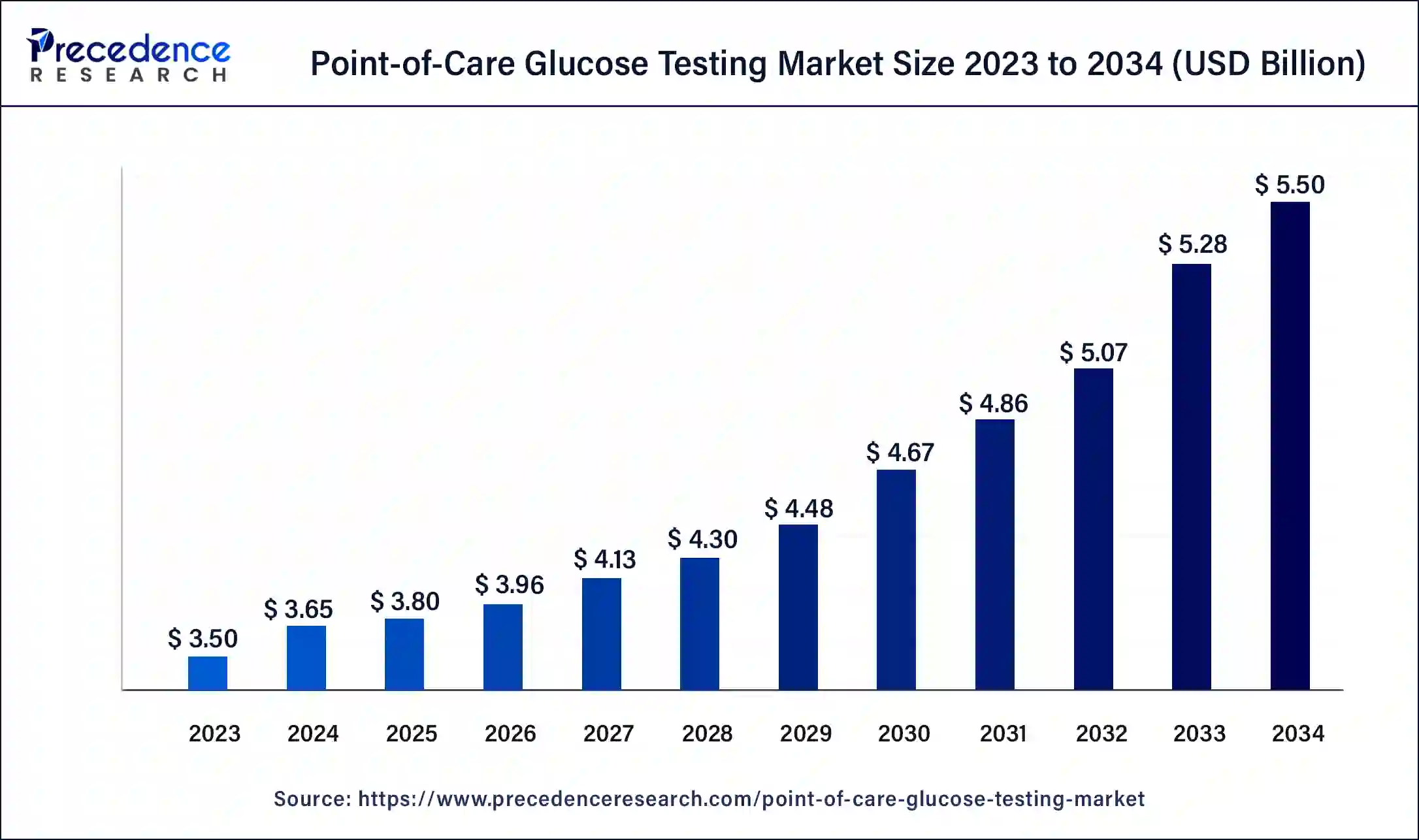
The U.S. point-of-care glucose testing market size was estimated at USD 1.01 billion in 2023 and is predicted to be worth around USD 1.62 billion by 2034, at a CAGR of 4.4% from 2024 to 2034.
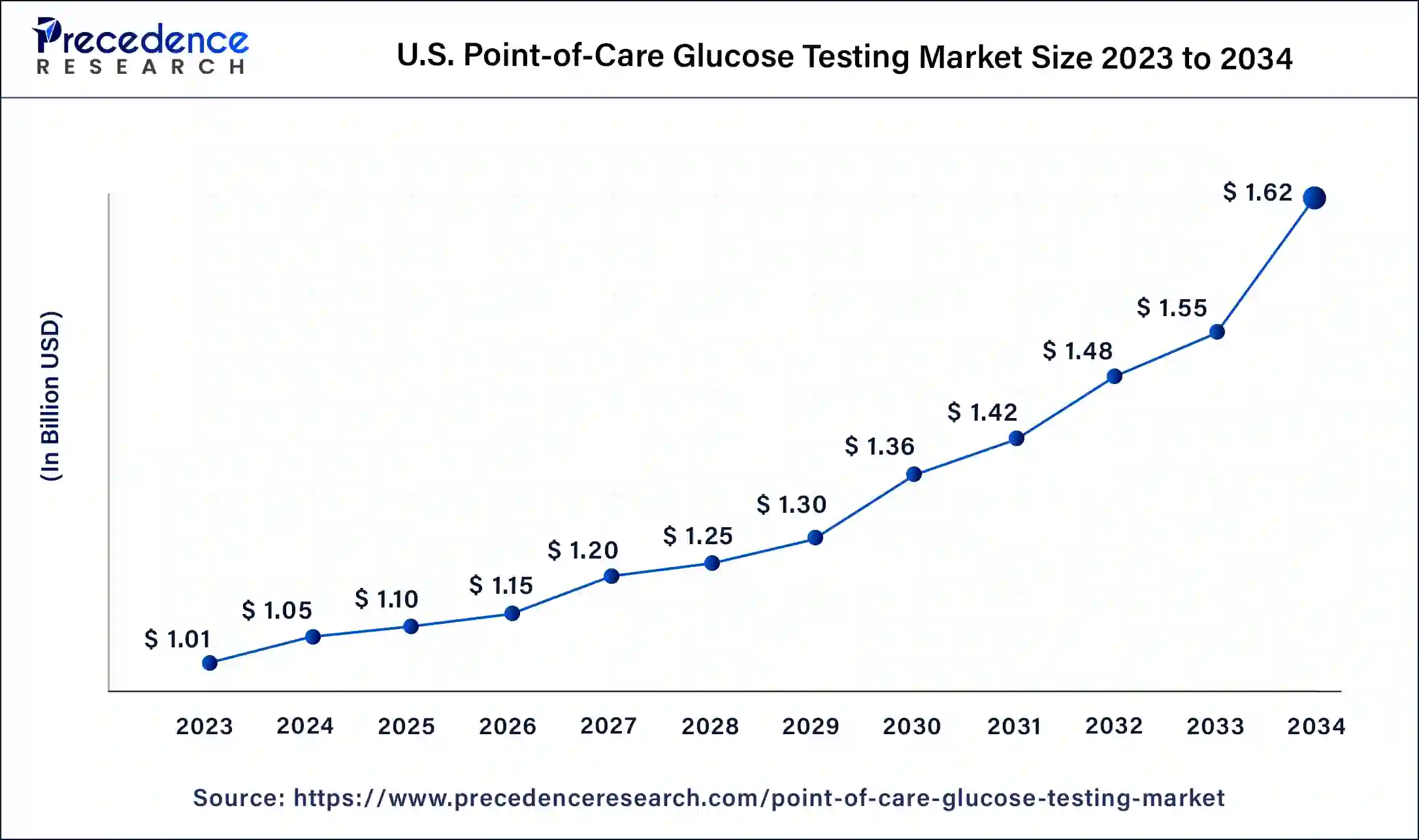
North America dominates the global point-of-care glucose testing market. This can be attributed primarily to factors such as the region's high diabetes rates, advanced healthcare facilities, and supportive reimbursement policies. The presence of major industry players, along with continuous technological advancements in glucose testing devices, further strengthens North America's position. Moreover, increased awareness among healthcare providers and patients regarding the advantages of point-of-care glucose testing contributes to market expansion in the region.
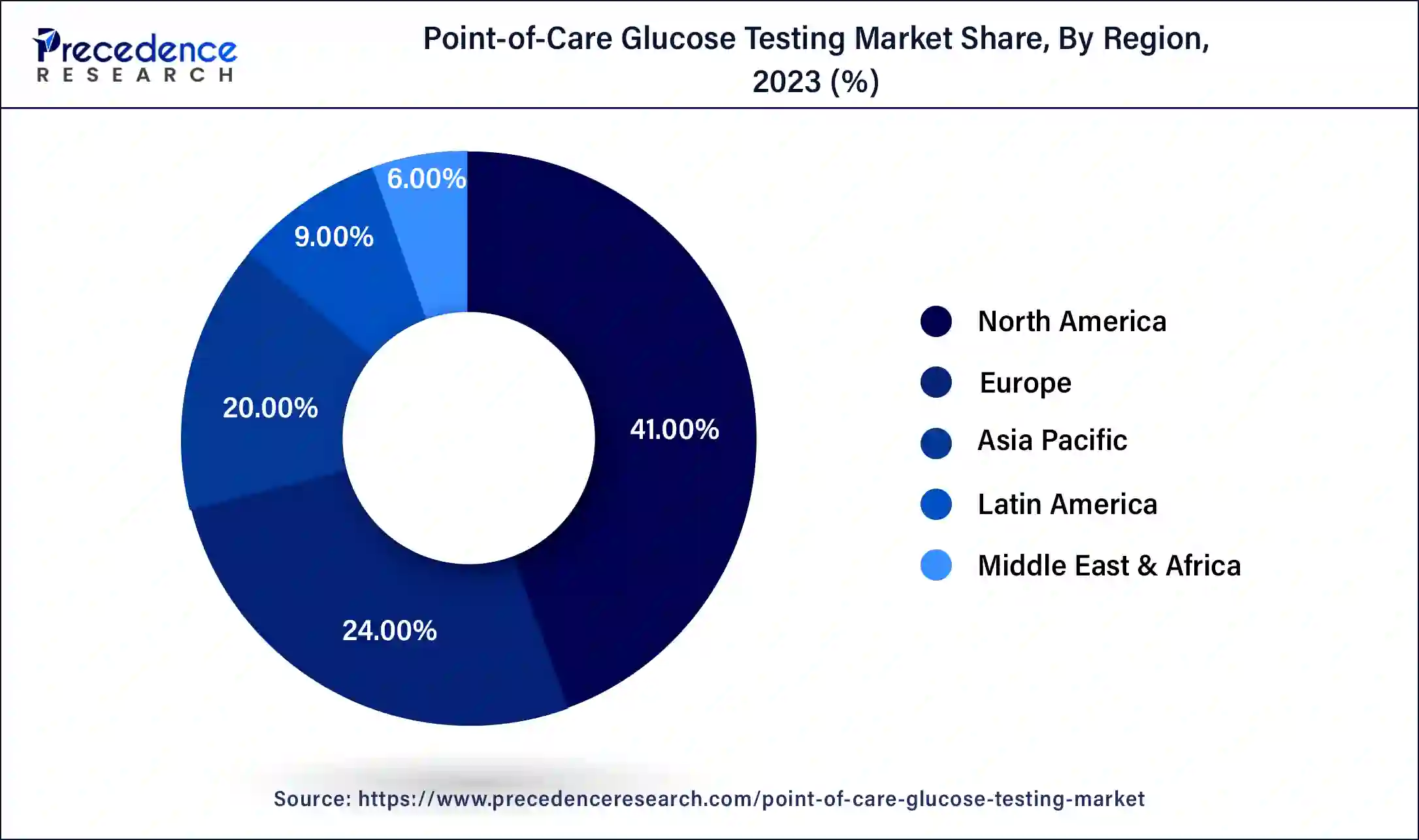
Asia Pacific is expected to witness significant growth in the point-of-care glucose testing market. This growth is driven by factors such as the rising prevalence of diabetes, a large population, increasing healthcare spending, and growing awareness about the importance of glucose monitoring. Additionally, improving economic conditions and healthcare facilities in countries like China and India are key drivers of market expansion. The use of point-of-care glucose testing devices in home settings and the emphasis on preventive healthcare also contribute to market growth in the Asia Pacific region.
Point-of-care glucose testing is a type of medical testing done right at the patient's bedside rather than sending samples to a lab. It's commonly used to manage diabetes, a condition where the body struggles to regulate blood sugar levels. This testing involves products like strips, lancets, and meters.
Recent advancements have led to better connectivity for handheld devices. These devices are now essential in hospitals and clinics worldwide for quick glucose monitoring. They use whole blood for measurement, which simplifies bedside testing. Moreover, they empower patients to manage their health actively, increasing demand for patient engagement solutions. This trend is expected to continue, driving the growth of the market.
Point-of-care testing allows individuals to actively manage their health by offering real-time information for better glucose level control. It promotes early detection, monitoring, and intervention, aiming to improve patient outcomes and overall diabetes management. A significant driver in this market is the increasing global prevalence of diabetes.
| Report Coverage | Details |
| Growth Rate from 2024 to 2034 | CAGR of 4.2% |
| Global Market Size in 2023 | USD 3.50 Billion |
| Global Market Size in 2024 | USD 3.65 Billion |
| Global Market Size by 2034 | USD 5.50 Billion |
| Largest Market | North America |
| Base Year | 2023 |
| Forecast Period | 2024 to 2034 |
| Segments Covered | By Product, By Application, and By End User |
| Regions Covered | North America, Europe, Asia-Pacific, Latin America, and Middle East & Africa |
Rising prevalence of diabetes
The prevalence of diabetes has risen globally due to factors like an aging population, urbanization, unhealthy lifestyle choices, and increased obesity and physical inactivity. This rise is particularly pronounced in low- and middle-income countries where healthcare access is limited and awareness about regular glucose testing is low. To address this, there's been a notable increase in the use of portable point-of-care glucose testing market devices due to their affordability and ease of use.
Government initiatives in developing and underdeveloped countries are promoting effective monitoring and surveillance of diabetes and its complications. These efforts are expected to significantly contribute to the point-of-care glucose testing market’s revenue growth in the future.
Technological advancements
Ongoing technological progress in glucose testing devices is fueling point-of-care glucose testing market expansion. Innovations like wireless connectivity, integration with smartphones, and cloud-based data management systems are improving the functionality and user-friendliness of point-of-care glucose testing devices. These advancements facilitate effortless data sharing, remote monitoring, and immediate insights for healthcare providers and patients alike.
Limited accuracy of point-of-care glucose testing devices
The accuracy of point-of-care glucose testing market devices has been a subject of ongoing debate. One of the challenges is determining which patients may be adversely affected by inaccurate results. False positive and false negative test results are common, leading to misdiagnosis in some cases. Many of these devices measure whole blood and hematocrit variations, which can introduce errors.
Organizations like the International Organization for Standardization and the Clinical and Laboratory Standards Institute have established new approval standards to address doubtful results. However, the low accuracy of these devices and the stringent regulatory approval processes may significantly hinder the growth of the point-of-care glucose testing market in the forecast period.
Development of advanced biosensor technologies
The development of highly advanced biosensor technologies, along with noninvasive glucose monitoring, grabs great potential for the market. Integration with electronic health records, telehealth services, and digital health platforms can further increase market opportunities. Moreover, the global point-of-care glucose testing market also provides efficient and immediate glucose monitoring for diabetes patients. These factors, along with the better disease management system, are expected to fuel market growth during the forecast period.
Innovations made by vendors
Vendors are striving to offer technologically advanced point-of-care glucose testing market products at competitive prices to gain an edge over their rivals. Among consumers, there's a preference for silk-based test strips due to their affordability compared to paper and plastic alternatives.
Silk strips only need a spray, as their coated threads can effectively conduct electrochemical signals, thereby reducing reliance on mechanical devices. By weaving enzyme-sprayed silk yarn together with electrodes, fabric sensors can independently conduct electrical charges. Also, the rising demand for cost-effective strips is expected to fuel growth in the point-of-care glucose testing market during the forecast period.
The lancing devices and strips segment held the largest share of the point-of-care glucose testing market in 2023 and is expected to maintain its position throughout the forecast period. This is mainly due to the increasing prevalence of diabetes and anemia, which drives the demand for lancets and lancing devices. The market is further boosted by the introduction of new lancing devices with features such as adjustable depth, vibration feedback, and pre-set depths.
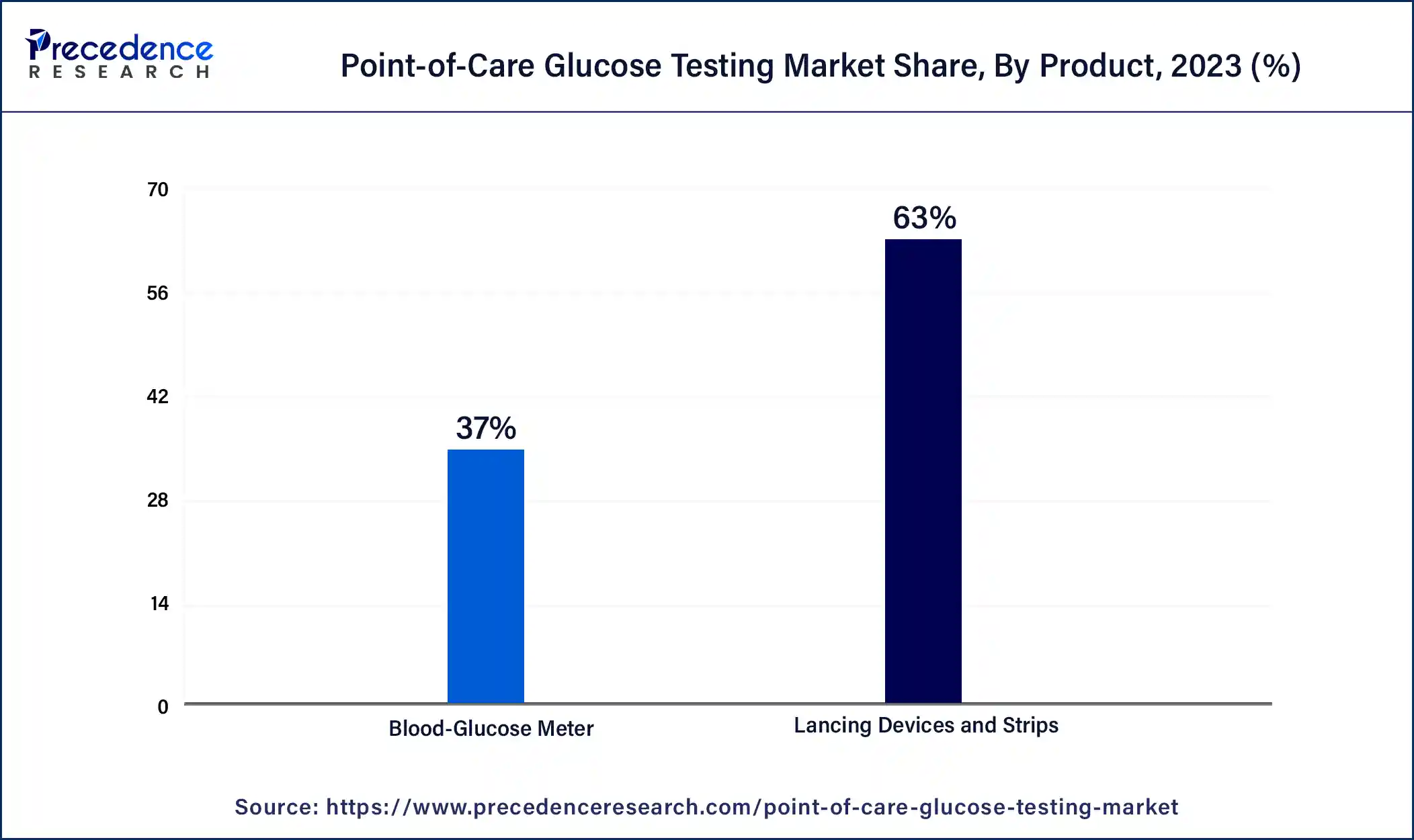
The blood glucose meter segment is expected to grow significantly over the projected period. This growth is driven by the increasing cases of diabetes and the growing awareness about its diagnosis. A glucose meter, also known as a glucometer, is a small device used to measure the amount of sugar in a blood sample. Typically, a drop of blood obtained through a finger prick is placed on a test strip, which is then inserted into the meter for analysis. The finger prick can be done using a special needle called a lancet or a spring-loaded device that quickly pricks the fingertip.
The type 2 diabetes segment dominated the point-of-care glucose testing market in 2023 and will continue to do so in the upcoming years. Factors such as the expansion of the healthcare sector and favorable government regulations are driving its global growth. Additionally, increasing government initiatives and favorable reimbursement policies are expected to further boost the growth of the type 2 diabetes segment in the future.
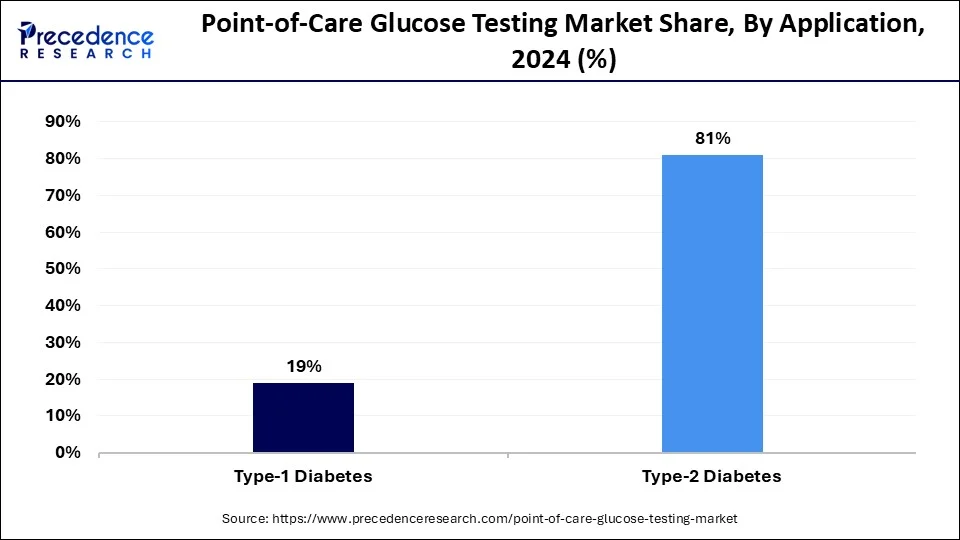
The same segment is estimated to experience substantial growth during the projected period. This is attributed to the increase in the number of type 2 diabetes cases worldwide and the increase in the research endogenous regarding type 2 diabetes.
The home care setting segment has led the point-of-care glucose testing market in 2023 and will sustain its dominance in the foreseen future. This is attributed to the widespread use of point-of-care glucose testing devices in home care settings, where many diabetes patients monitor their glucose levels after meals. The segment's growth is also driven by an increase in the elderly population requiring medical care at home and rising awareness among people about using point-of-care glucose testing devices at home.
Segments Covered in the Report
By Product
By Application
By End User
By Geography
For inquiries regarding discounts, bulk purchases, or customization requests, please contact us at sales@precedenceresearch.com
No cookie-cutter, only authentic analysis – take the 1st step to become a Precedence Research client
January 2025
February 2025
November 2024
October 2024